- QCOM shares leapt after a big earnings beat at the start of November
- The shares have lagged the semi industry substantially over the past 12 months
- The company is poised for substantial growth in auto market applications
- The Wall Street consensus outlook is bullish
- The market-implied outlook for 2022 is moderately bearish
Qualcomm (NASDAQ:QCOM) is a major provider of semiconductor chips and related software and services, principally for mobile computing and communications. The company is positioning itself to lead in high-growth applications in the auto industry (via the company’s Digital Chassis offerings), virtual reality/augmented reality, and the Internet of Things (IoT).
General Motors (NYSE:GM) just announced that it will use QCOM technology for its new hands-free driver assistance offering. QCOM is building from a position of strength with its massively successful Snapdragon chipsets for mobile computing and communications.
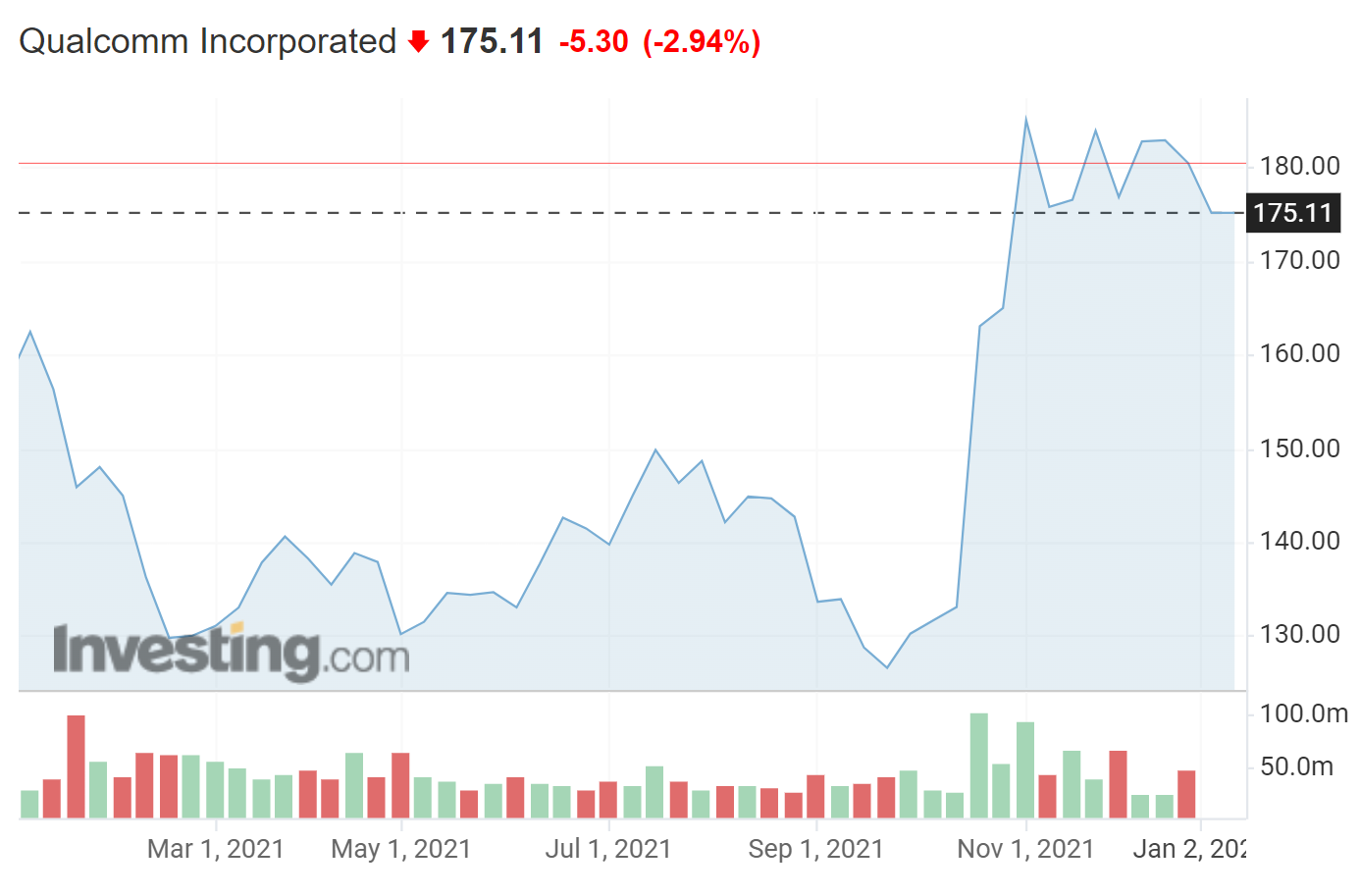
Source: Investing.com
After spending most of 2021 below January highs, QCOM shot up following strong results for FY Q4 of 2021, reported on Nov. 3. Even with the big gains, QCOM’s total return over the past year is substantially lower than that of the Semiconductor industry over the past 12 months.
While the 3-year performance is in line with the industry, the 5- and 10-year annualized total returns substantially lag.

Source: Morningstar
QCOM has beaten the analyst EPS expectations for a number of quarters, with double-digit outperformance (on a percentage basis) for the last 3 quarters. The consensus expected EPS for FY Q1 of 2022 is notably higher than the Q4 results.
If the growth outlook holds up, QCOM looks reasonably priced at the current level. The forward P/E is slightly lower than it was back in early March (16.9% today vs. 17.7% then), when the shares were trading at $129.

Source: E-Trade. White values for past quarters are the reported EPS and green values are the amount by which this valued exceeded the consensus expected level.
Rather than attempting to provide my own bottom-up evaluation for QCOM, I rely on two forms of consensus outlooks. The first is the well-known Wall Street analyst consensus rating and 12-month price target. The second is the market-implied outlook, a probabilistic price return forecast that represents the consensus outlook of buyers and sellers of options on QCOM.
The price of an option on a stock reflects the market’s consensus estimate of the probability that the stock price will rise above (call option) or fall below (put option) a specific level (the strike price) between now and when the option expires. By analyzing the prices of call and put options at a range of strikes, all with the same expiration date, it is possible to calculate the probabilities of the range of possible price returns that reconciles the options prices. This is the market-implied outlook.
When I last analyzed QCOM, on Mar. 8. 2021, the shares were trading at $129. The Wall Street consensus 12-month price target was about 30% above the share price at that time and the consensus rating was bullish. The market-implied outlook to Jan. 21, 2022 was bearish, with expected volatility of 39% (annualized).
I balanced the bullish Wall Street view with the bearish market-implied outlook to come up with an overall rating of neutral. Since that analysis, QCOM has had a total return of 39.3%, almost twice the return of the S&P 500.
With ten months since my last analysis and QCOM almost 40% more expensive, I have updated the market-implied outlook for QCOM for comparison to the current Wall Street consensus outlook.
Wall Street Analyst Consensus Outlook for QCOM
E-Trade calculates the Wall Street consensus rating and price target using the views of 21 ranked analysts who have published their opinions within the past 90 days. The consensus rating for QCOM is bullish and the consensus 12-month price target is 12.49% above the current share price. Of these 21 analysts, 12 assign a buy rating and 9 rate QCOM as a hold.
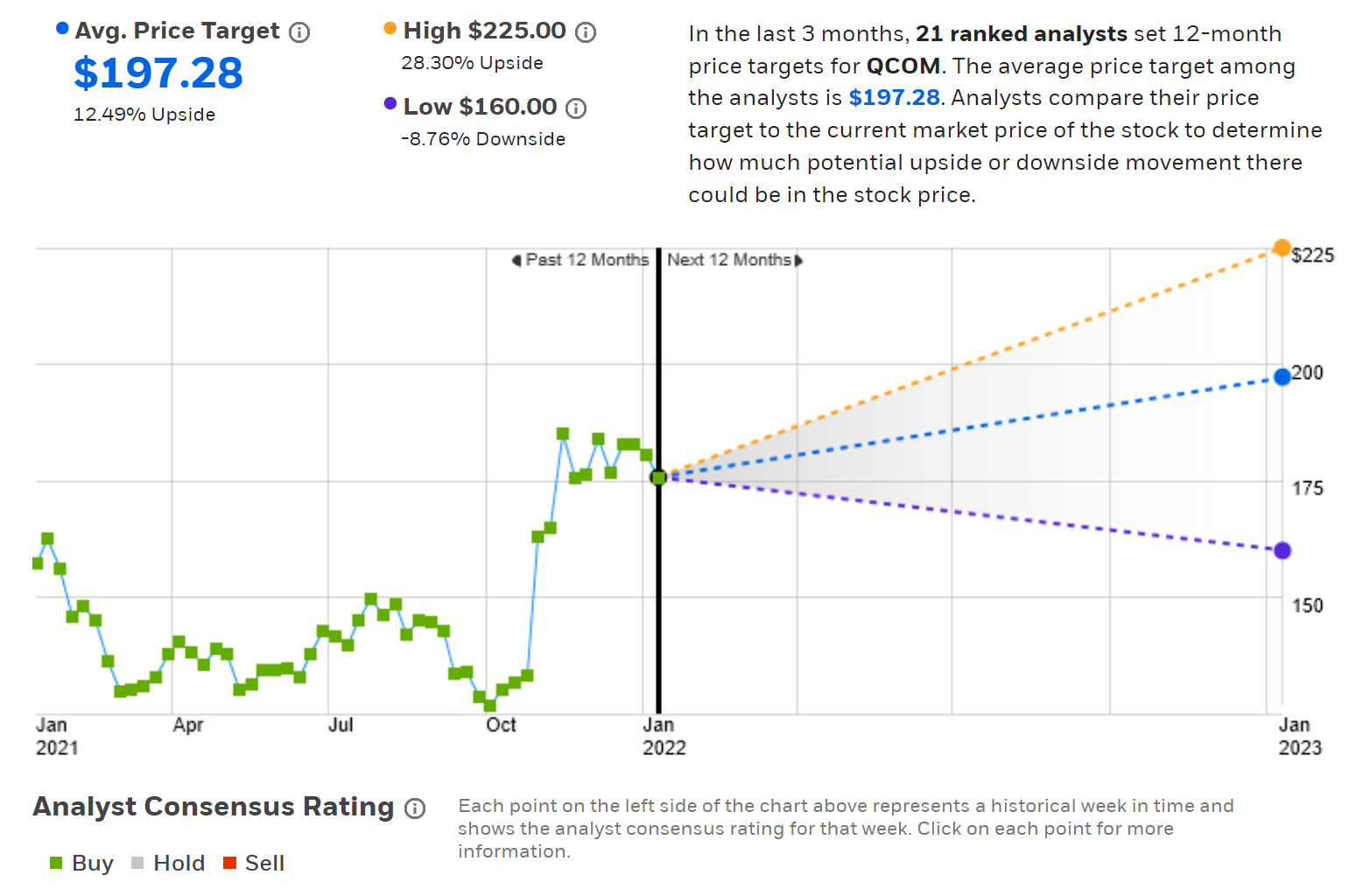
Source: E-Trade
Investing.com calculates the Wall Street consensus outlook by combining the views of 35 analysts. The consensus rating is bullish and the consensus 12-month price target is 16.32% above the current share price. Similar to E-Trade’s analyst cohort, none of the individual analysts assigned a rating below neutral.
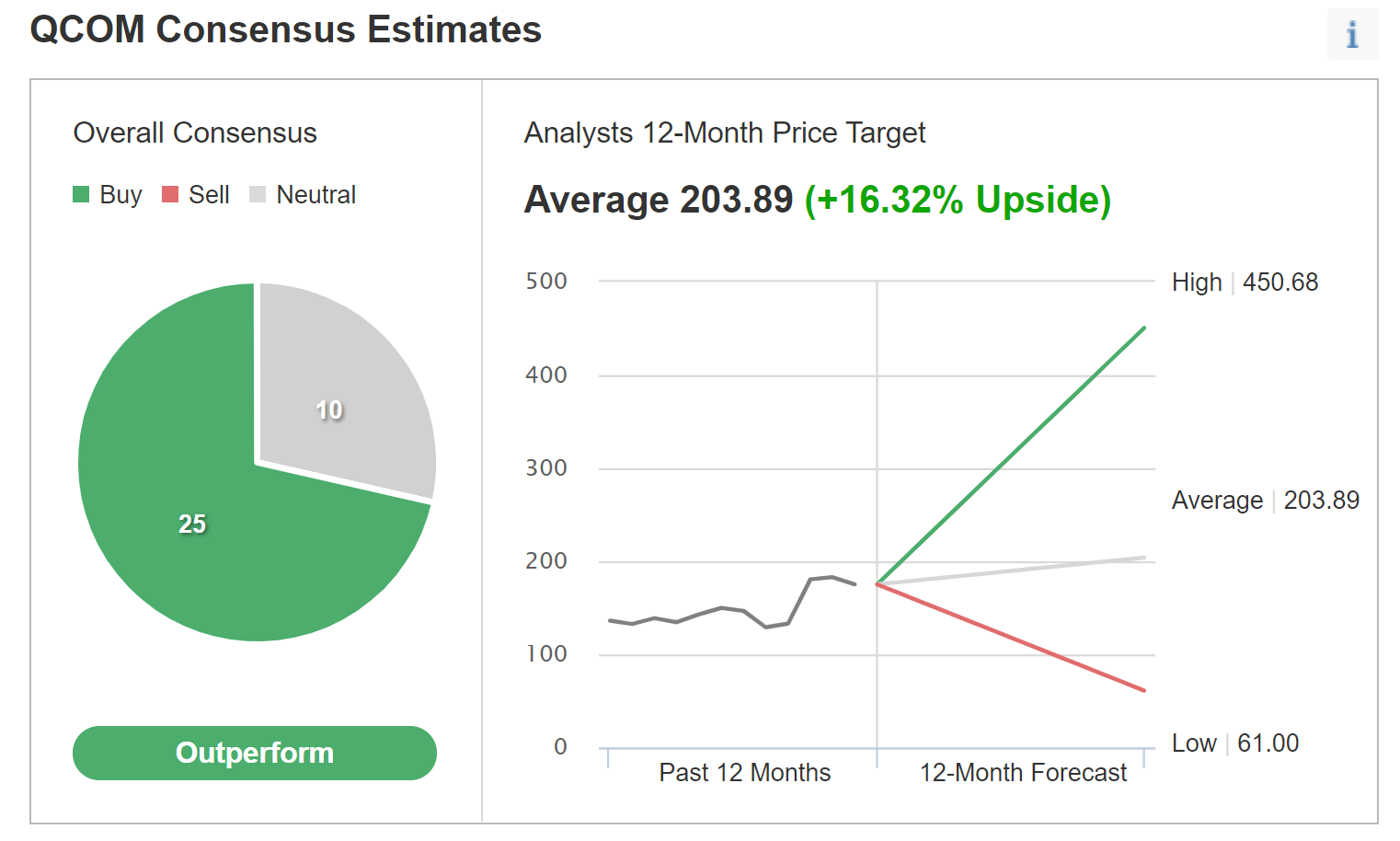
Source: Investing.com
E-Trade’s and Investing.com’s version of the Wall Street consensus are very similar, with an overall bullish rating and a 12-month price target that is 12.5% to 16.3% above the current price (average of 14.4%). Combined with the 1.5% dividend yield, the consensus for 12-month total return is about 15.9%.
This is slightly lower than QCOM’s 2021 total return and far below the trailing 3- and 5-year annualized returns. Whether or not the consensus outlook for total return is attractive depends on how risky the next year looks, a topic I address in the next section.
Market-Implied Outlook for QCOM
I have calculated the market-implied outlook for QCOM for the 5.2-month period from now until June 17, 2022 and for the 12.3-month period from now until Jan. 20, 2023, using the prices of options that expire on these two dates.
The standard presentation of the market-implied outlook is in the form of a probability distribution of price return, with probability on the vertical axis and price return on the horizontal.
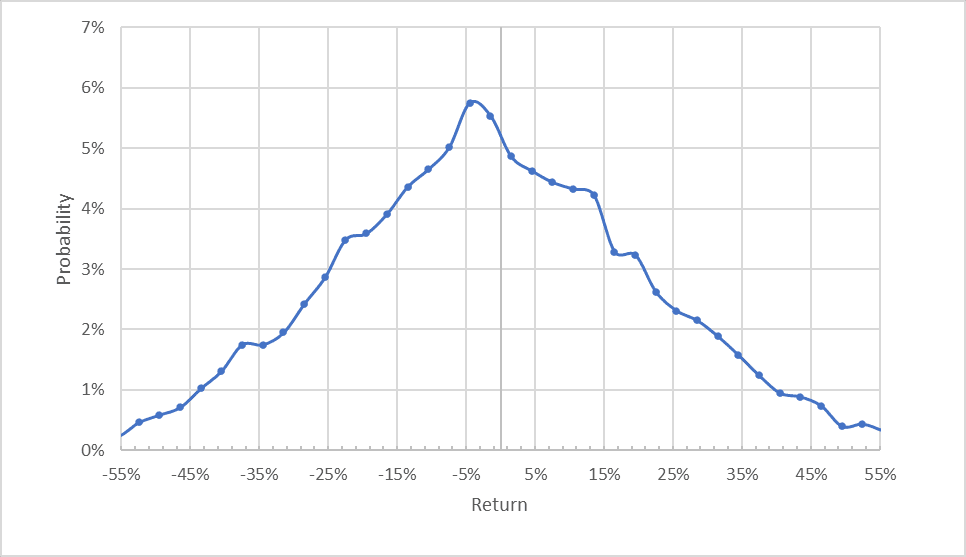
Source: Author’s calculations using options quotes from E-Trade
The market-implied price return probabilities for QCOM until the middle of 2022 are generally symmetric, with comparable probabilities of positive and negative returns of the same magnitude, although the maximum probabilities slightly favor negative price returns.
The peak probability corresponds to a price return of -4%. The annualized volatility calculated from this distribution is 42.7%. This level of volatility is quite close to the value from the market-implied outlook in March of 2021.
To make it easier to directly compare the probabilities of positive and negative returns, I rotate the negative return side of the distribution about the vertical axis (see chart below).
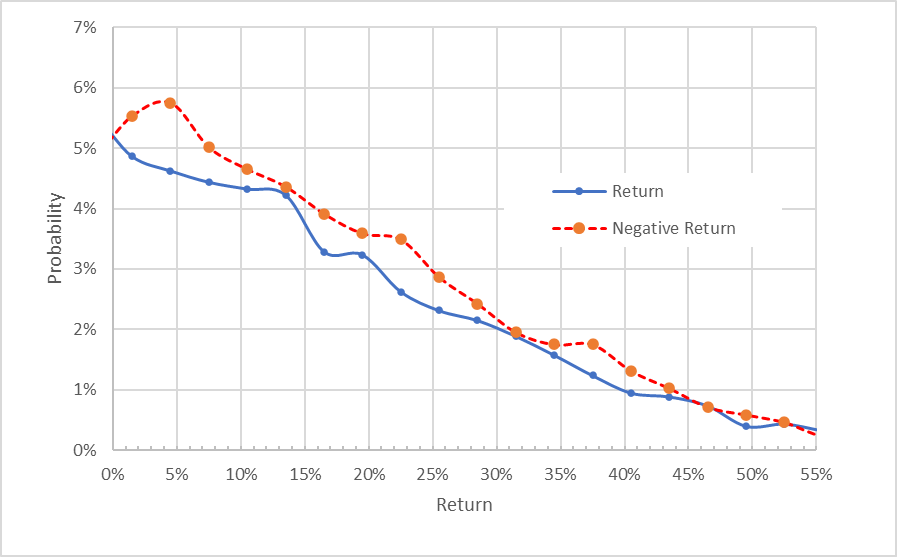
Source: Author’s calculations using options quotes from E-Trade. The negative return side of the distribution has been rotated about the vertical axis.
This view shows that the probabilities of negative returns are consistently, albeit mildly, elevated relative to the probabilities of positive returns of the same magnitude (the red dashed line is above the solid blue line). On its face, this would seem to indicate a bearish outlook, but we expect that market-implied outlooks may have a negative bias. Because, in aggregate, investors are expected to be risk averse, they are likely to pay more than fair value for downside protection (put options). This, in turn, would create a negative bias in the market-implied outlook. As such, this market-implied outlook for QCOM is best interpreted as neutral.
Looking all the way through 2022, calculating the market-implied outlook using options that expire on Jan. 20, 2023, the view is more bearish. The spread in probabilities to favor negative returns is more pronounced (the red dashed line is further above the solid blue line).
While it is not possible to robustly estimate the potential size of the risk aversion bias in the market-implied outlook, the tilt to favor negative returns is now large enough that I interpret it as bearish. That said, the apparent bearish tilt is considerably less pronounced than it was back in March. The annualized volatility calculated from this distribution is 39.6%, almost identical to the value I calculated in March.
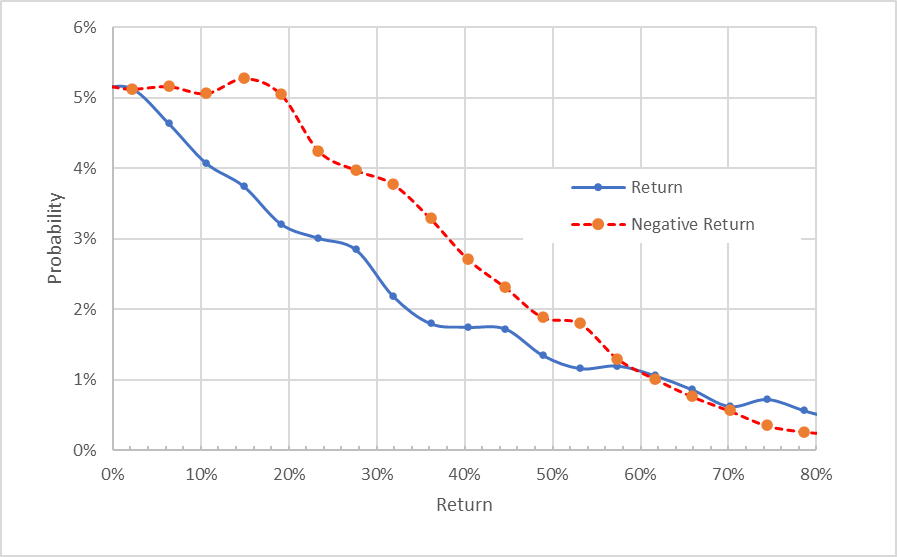
Source: Author’s calculations using options quotes from E-Trade. The negative return side of the distribution has been rotated about the vertical axis.
The market-implied outlook is neutral to mid-2022 and somewhat bearish for the full year. The expected volatility is fairly stable at about 40% (annualized).
Summary
QCOM has successfully grown EPS over the past several years. The qualitative outlook for the company is favorable, with hardware and software that powers increasingly autonomous vehicles. In addition, the company has a strong position in mobile processors.
That said, QCOM has substantially underperformed the Semiconductor industry over the past 12 months, indicating that the market has concerns about the forward-going value proposition. The Wall Street consensus rating for QCOM is bullish and the consensus 12-month price target implies 15.9% in total return.
With expected volatility of 40%, however, 15.9% in return is not terribly attractive. As a rule of thumb for a buy, I want to see an expected 12-month return that is at least half the expected volatility and QCOM does not quite reach this level.
The market-implied outlook is neutral to the middle of 2022 and moderately bearish for the full year. With the shares trading near their all-time highs, I am maintaining my neutral rating on QCOM. A caveat is that I underestimated the firm in my last analysis using the same approach.
